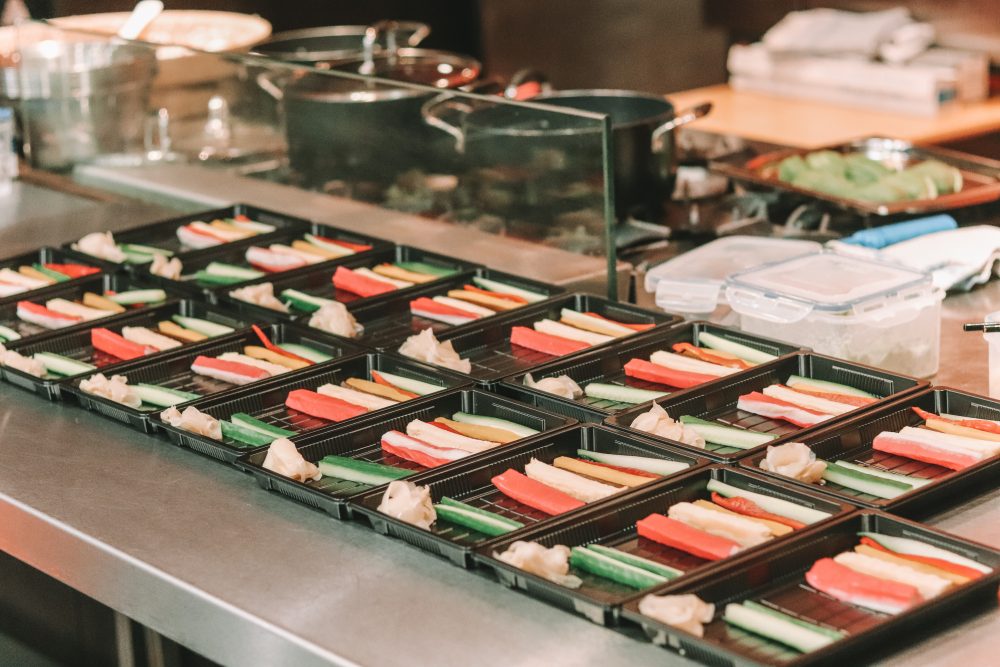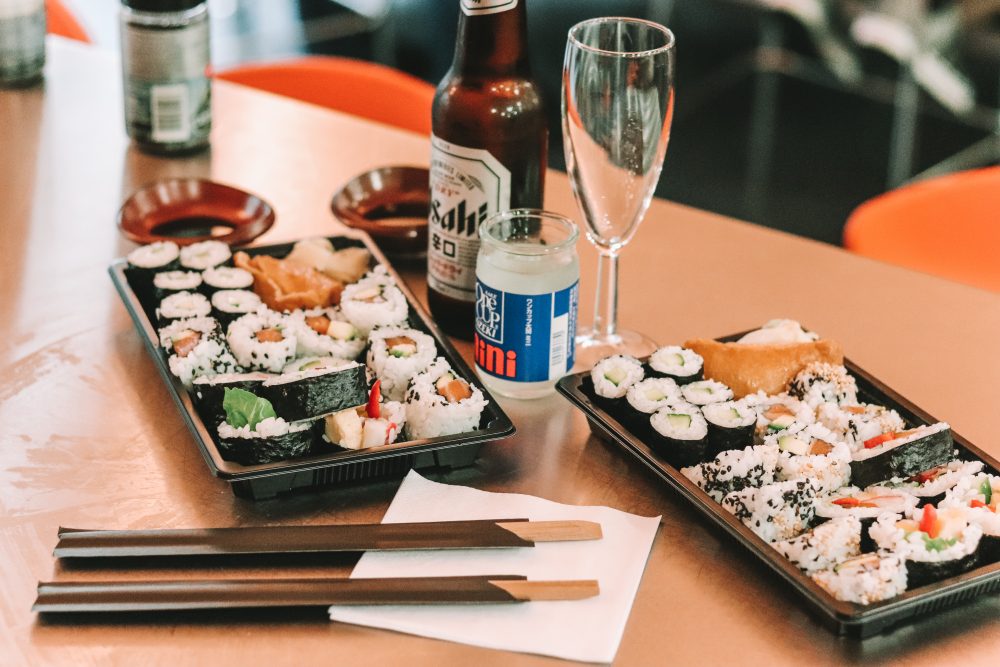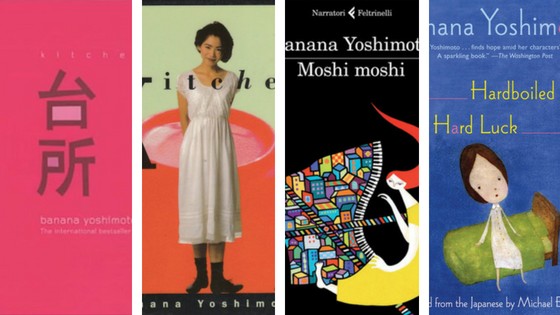Are you wondering if you eat sushi the right way? Perhaps you’re new to sushi and are confused by the types of sushi on offer. Maybe you’ree someone who loves sushi but has difficulty ordering or eating without feeling self-conscious in a restaurant.
Sushi is much more than simply a Japanese delicacy that has been adapted in various forms in the West. It’s an experience in itself and when you know how to order and eat it correctly, you will get so much more out of each visit to sushi restaurants.
Some of the common varieties of fish used in sushi are tuna, salmon, yellowtail, mackerel, seabass, snapper, and halibut, You can also find seafood like shrimp, octopus, scallops, squid, clams, sea urchins, and eel. Octopus and sea urchin are an acquired taste so and may take some getting used to.
In this ultimate guide to eating sushi, we will discuss the different choices you can make when ordering sushi, understanding the different items on your plate, learn the correct method of eating sushi, and also some sushi etiquette.
How To Order Sushi At Restaurant
As you walk into a sushi restaurant, the staff will welcome you by saying ‘irasshaimase’. Greet the staff with a warm smile and if possible reply back saying ‘Ojama shimasu’. Now, just take your seat at the sushi bar or at one of the tables. If you are a beginner, we would recommend that you avoid the bar to feel less conscious of fellow eaters. Take the table instead so that you can eat at your own pace.

The menu will typically include maki or sushi rolls, nigiri sushi, temaki sushi, and sashimi. You will find the ingredients listed below the items in most menus which makes it easier to choose. If there are Japanese names or you don’t understand something, feel free to ask the server. You may also ask the chef or server for recommendations and they will be happy to suggest dishes to you.
If you are a beginner, make sure you let the chef or server know so that they can help you with the lightest variety of raw fish and then take you to the fatty versions. Those who don’t like the idea of eating raw seafood, still have a plethora of cooked and vegetarian sushi options to choose from. Some examples are shrimp tempura roll, California roll, avocado roll, cucumber maki, and inarizushi.
If you have any dietary reservations such as gluten-free or if you’re vegan then let the server know that too. Some restaurants use tamari sauce instead of soy sauce for people who are allergic to gluten or have gluten-free soy available.
You may ask any questions but remember to never ask ‘Is the fish fresh?’ as this is considered rude. All reputed sushi places use only sushi-grade fish of highest quality, so you can put your worries to rest.
Read More: The Ultimate Guide to Japanese Rice Balls – Onigiri
Types of Sushi – Knowing What’s On Your Plate
There are many types of sushi on offer so don’t get stumped on figuring out your nigiri from your maki and eat sushi like a pro.
Maki Rolls (Makizushi)
If you have ordered a maki or sushi roll, expect to find bite-sized pieces (6-8) served on the plate. At the side, you’ll find condiments like soy sauce, wasabi paste, and pickled ginger.
A maki roll typically includes nori or seaweed on the outer side, a layer of vinegared sushi rice beneath it and fillings may include raw fish, seafood, veggies, or fruits. Maki has many sizes and variations and can be categorised into hosomaki, futomaki, and uramaki.

Nigiri sushi
Compromising of a bed of seasoned sushi rice topped with a carefully cut piece of raw fish, sometimes held together by a nori strip. The chef uses the warmth of his hands to mould the nigiri into a beautiful form. Applying some soy sauce and wasabi between the fish and rice balances the flavours. Nigiri is meant to be eaten in one go or in a maximum of two bites without destroying its form.
Temaki sushi
Nori on the outside with a layer of rice and fillings inside, Temaki is shaped like a cone instead of a cylinder. There are several other forms of sushi such as the inside-out rolls wherein the nori is hidden between the rice layer and fillings. The inside-out roll or uramaki is mostly garnished with sesame seeds, masago (fish eggs), and tobiko (fish eggs).
Inarizushi
A wonderful vegan sushi option and absolutely addictive, these deep-fried tofu pockets are filled with sushi rice seasoned with vinegar. They’re one of the most simple and delicious types of sushi on offer and very filling! The name is related to the Inari god and the relationship to foxes who are said to enjoy the fried tofu left as offerings.
Although the shape of the fried tofu is said to resemble a crouching fox which is easier to see in the dish Kitsune Udon which has the same fried tofu topping and foxy legend.

Oshizushi (Pressed Sushi)
Most commonly associated with Osaka which is one of the easiest places to try this unique type of sushi. Literally meaning pressed sushi box, a traditional wooden (and now often plastic) box called oshibako is used to press the sushi rice and seafood like eel or mackerel into perfect blocks.
Gunkan Maki
Literally meaning ‘war-boat’, you can immediately see why with the tall wrap of nori holding in the rice and an overflowing centre. It’s certainly one of the most impressive and daresay intimidating types of sushi. A type of nigiri sushi, the rice is shaped by and the final filling will usually include roe, crab, or sashimi.
Seasoning Your Sushi
Your soy sauce will be served in a small bowl, make sure to dip the sushi slightly in it before putting it into your mouth. Add a little green wasabi to the pieces if you wish to increase the heat (please be warned that a little bit of wasabi can be too much). The pickled ginger is to help you cleanse the palate before trying a new variety of fish so that you can identify the flavours.
Read More: A Guide to Japanese Snacks (And Where to Buy Them)
Sashimi Vs Sushi
Many people mix up these two dishes and can even put people off trying sushi because they think raw fish is always involved. Without considering the fact that there are many vegetarian and even vegan sushi options.
Sashimi is sliced raw fish and while you approach it much in the same way as sushi, as in you’ll select small dishes and dip it’s also very much it’s own thing and layered sashimi bowls featuring different fish are very popular. Rice isn’t typically involved which separates it from some sushi options which do include raw fish.
What’s the Correct Way To Eat Sushi?
You will find a pair of chopsticks on the table or served to you with the sushi plate. If you don’t know how to use chopsticks, simply don’t bother. There’s nothing to feel ashamed or self-conscious about as sushi is best eaten by hand! Pick the sushi with your hands, dip the fish part (in case of nigiri) slightly in the soy sauce and put it in your mouth.
When you are done eating, take a small bit of pickled ginger and chew it well to cleanse your palate before tasting the next item. Don’t add wasabi before tasting a piece. The chef has already balanced the flavours and ideally, you should not need any extra wasabi or even soy sauce. Sushi tastes best when you trust the master chef and go with his choice.
While it’s okay to not use chopsticks, it’s certainly not right to play with it. Please remember that there are a few sushi etiquette rules you need to follow when you are in a sushi restaurant or bar.
Simple Sushi Eating Etiquette
- Never play with the chopsticks as it’s considered a rude gesture
- Avoid mixing soy sauce and wasabi to create an ugly green dip
- Don’t slather your sushi with too much soya sauce and don’t take pics without the chef’s permission
After you are done eating, wash your hands in the bowl of warm water kept on the table, dry hands with the towel, and thank the chef for a great experience. A great sushi dinner is best concluded with a glass of Japanese lager, sake, or wine. Buy your chef a glass of beer as a token of your appreciation and he will remember you and your preferences when you visit next.



